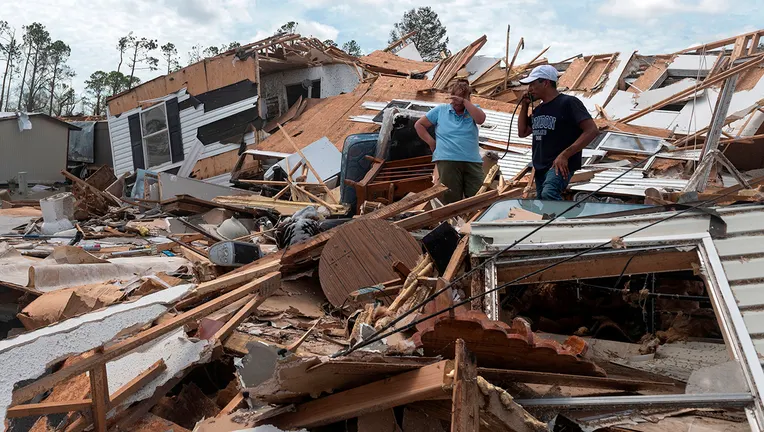The most potent storms on the globe are changing in behavior. We must understand how hurricanes, typhoons, and tropical cyclones are evolving if we are to prepare for increasingly severe storms.
Typhoons, tropical cyclones, and hurricanes are commonly referred to as nature’s steam engines because of the heat they generate from the ocean. When they speed over the seas, the heat they absorb is transformed into violent kinetic energy that destroys islands and submerges coastal cities, necessitating months of urgent repairs. These “engines” are responding to the record-breaking ocean temperatures by slowing down, changing their course, and becoming less predictable and more hazardous.
In an attempt to figure out how to adapt, scientists are currently racing to figure out exactly how hurricanes are rewriting the norms and patterns we’ve observed in the past.
An extended season
Hurricane activity in the Atlantic follows a clear seasonal pattern, peaking in September and occurring very rarely or not at all in the winter. As a result of climate change, a robust and early hurricane season is to be expected, according to James Kossin, a retired US National Oceanic and Atmospheric Administration (Noaa) climate and atmospheric scientist.
Hurricane Bebinca
Strong Typhoon Bebinca made landfall close to Shanghai, China, early on September 16. Chinese official media reported that the typhoon was the strongest storm to hit the city in 75 years.
Before the storm arrived, hundreds of thousands of residents were evacuated.
“Hurricanes themselves just respond to the environment that they’re sitting in,” explains Kossin. “Therefore, the hurricanes will act as though it is August or September if the environment in June is made to resemble the environment that would typically be in those months. They are without a calendar.
Climate warming is the primary cause of the abnormally warm ocean conditions we are currently seeing, but other factors, like the current El Nino to La Nina transition, which tends to increase storm activity, have also contributed to this season’s activity.
“We would expect the waters to be at the warmth that we need for hurricane earlier in the year in a warming climate,” says Kristen Corbosiero, an associate professor at the University at Albany in New York, who specializes in atmospheric and environmental sciences. “So it’s certainly possible that we will see earlier seasons and longer hurricane seasons moving forward.”

It’s too early to notice a regular shift in the season, even though the extreme early start to the 2024 season brought on by Hurricane Beryl is consistent with what climate scientists could anticipate to see with climate change. According to Columbia University ocean and climate physics professor Suzana Camargo, “[It’s] not something that appears clearly in the data yet.”
“Death is sheer.”
Hugh Willoughby, a research professor of earth and environment at Florida International University, believes that one of the greatest storms to form recently in the Atlantic did so in circumstances that should have precluded a hurricane from forming.
During the height of the Atlantic season in September 2023, Hurricane Lee quickly strengthened into a category five hurricane. El Niño, which typically stifles storms in the Atlantic due to greater wind shear and atmospheric stability, was in effect at the time.
“Shear is death for hurricanes,” Willoughby asserts. High wind shear disrupts a hurricane’s structure. Vertical wind shear is the variation in wind direction and speed at various heights. “Imagine you’ve got a turbine engine – shear knocks some of the blades out,” says Willoughby.
It was therefore “a nasty surprise” that a category five hurricane like Hurricane Lee formed despite significant shear. Willoughby speculates that the unusually warm water in September 2023 may have, for reasons that are now unclear, outweighed the impact of shear.
Increased intensity
According to Willoughby, the great majority of hurricanes that begin in the Atlantic never achieve their full capacity. Within the narrow confines of the Atlantic Basin, storms frequently make landfall before reaching their maximum intensity or encounter strong wind shear, which aids in the storm’s dissipation.
“But when everything goes right it’ll intensify rapidly and reach its maximum potential intensity, which is defined by the ocean surface temperature below the hurricane,” Willoughby explains.
As the waters warm, there is “a heck of a lot of evidence” that intensification rates are rising, giving storms more fuel, according to Kossin.
“It all comes down to the amount of fuel available,” he states. It’s similar to altering a carburettor’s jets. You will gain more horsepower if you adjust the jets to let more fuel in and mix with the air. It will be possible for you to reach 60 more quickly from zero. And you’re intensifying with that.”
Greater peak intensity
Along with climate change, hurricanes’ peak intensities have also increased. According to a 2020 study by Kossin, storm strength increased by roughly 6% every ten years between 1979 and 2017. The likelihood of a storm reaching the speed of 111 mph (180 km/h) needed to be designated as a major hurricane has increased by 25% in the last 40 years.
Overall, the International Panel on Climate Change (IPCC) predicts that the percentage of tropical storms that are category three or above is probably rising.
“The ocean temperature defines the maximum intensity the hurricane can reach,” Willoughby explains.
According to a BBC report published in May 2024, global ocean temperatures have surpassed daily records for the year before.
Deceleration
Hurricanes are moving slower along their courses across land and ocean, even if the wind speeds inside them are increasing.
According to a 2018 study by Kossin, since the turn of the 20th century, hurricanes that hit the US have slowed down by about 17%. In the western North Pacific, tropical cyclone speed decreased by up to 20%.
The uneven global warming caused by climate change, with the Arctic rising about four times faster than the rest of the planet, is assumed to be the cause of the slowdown. Consequently, the temperature differential between the tropics and the Arctic is decreasing. “It’s that temperature gradient that drives the winds,” Kossin states. “The stronger the gradient, the stronger the winds.”

He suggests comparing hurricanes to a cork in a stream. “They just go where the wind takes them.” Furthermore, if you reduce wind speed, storms will also decrease in speed as they travel.
More rain is anticipated
Consider the difference between swiftly hosing down a flowerbed with a garden hose and holding it there for a longer period of time. A slow-moving hurricane has more time to dump rain in a particular area. On August 5, 2024, Hurricane Debby, a particularly sluggish category one hurricane, was predicted to move northward from Florida’s Gulf Coast into Georgia and South Carolina, bringing with it up to 30 inches (76 centimeters) of rain and devastating floods.
“What really is going to give you a lot of rain is when you slow these [storms] down,” Kossin states. “When they stop, or what we call ‘stall out’, it’s just devastating because you get inundated for days.”
The length of the wind also affects how much damage it causes; the longer the wind hits a structure, the greater the chance that it may topple it. “It’s just bad having a hurricane stick around very long,” Kossin said. “You want it to get out of your neighborhood.”
Hurricanes may get even wetter due to the fact that warmer air has the capacity to hold 7% more moisture per degree Celsius. The additional moisture brought on by rising temperatures does have an impact, but Kossin claims that it is minimal in comparison to the disruption caused by a hurricane that is stalling out.
Kossin claims that this slowness is the most serious manner that climate change is affecting hurricanes because of this. “That’s a really big deal.”
Hurricane patterns are evolving
When thinking about how hurricanes are changing, Kossin warns against having a tunnel vision because to the emphasis on intensity and strength. “People don’t talk about track enough,” he claims. “And I think that it’s by far more dangerous.”
Kossin and associates discovered in a 2014 study that storms in the northern hemisphere were moving northward by 53 kilometers (33 miles) per ten years. They had traveled 62 kilometers (39 miles) southward per decade in the southern hemisphere. The hurricanes were generally advancing their latitude away from the tropics by one degree every ten years.
Communities may become vulnerable to severe storms in areas they were not previously familiar with. According to Kossin, there is a modest drop in risk near the Philippines due to the migration of tropical cyclones, but an increase in risk towards Japan in the Western Pacific.
“The Philippines is relatively accustomed to [cyclones] as they occur frequently there. They do occur in Japan, but not always,” Kossin explains. We are now predicting that they will begin to experience storms that are stronger than those that previously reached them. That has a fairly significant impact on risk.”
Loss of the smog barrier
A reduction in air pollution in the US and Europe since the 1970s is believed to have had an unforeseen consequence, warming the air over the Atlantic further, in addition to the rise in greenhouse gas levels.
High concentrations of industrial sulfate pollutants used to mix across the Atlantic Basin, preventing sunlight from reaching the ocean, which had a cooling impact, according to Kossin.
Since the industrial revolution, climate change has been occurring, but according to Kossin, “we’ve been suppressing that warming with this pollution.” That cooling effect subsided following the remarkably successful reduction of industrial pollutants.
